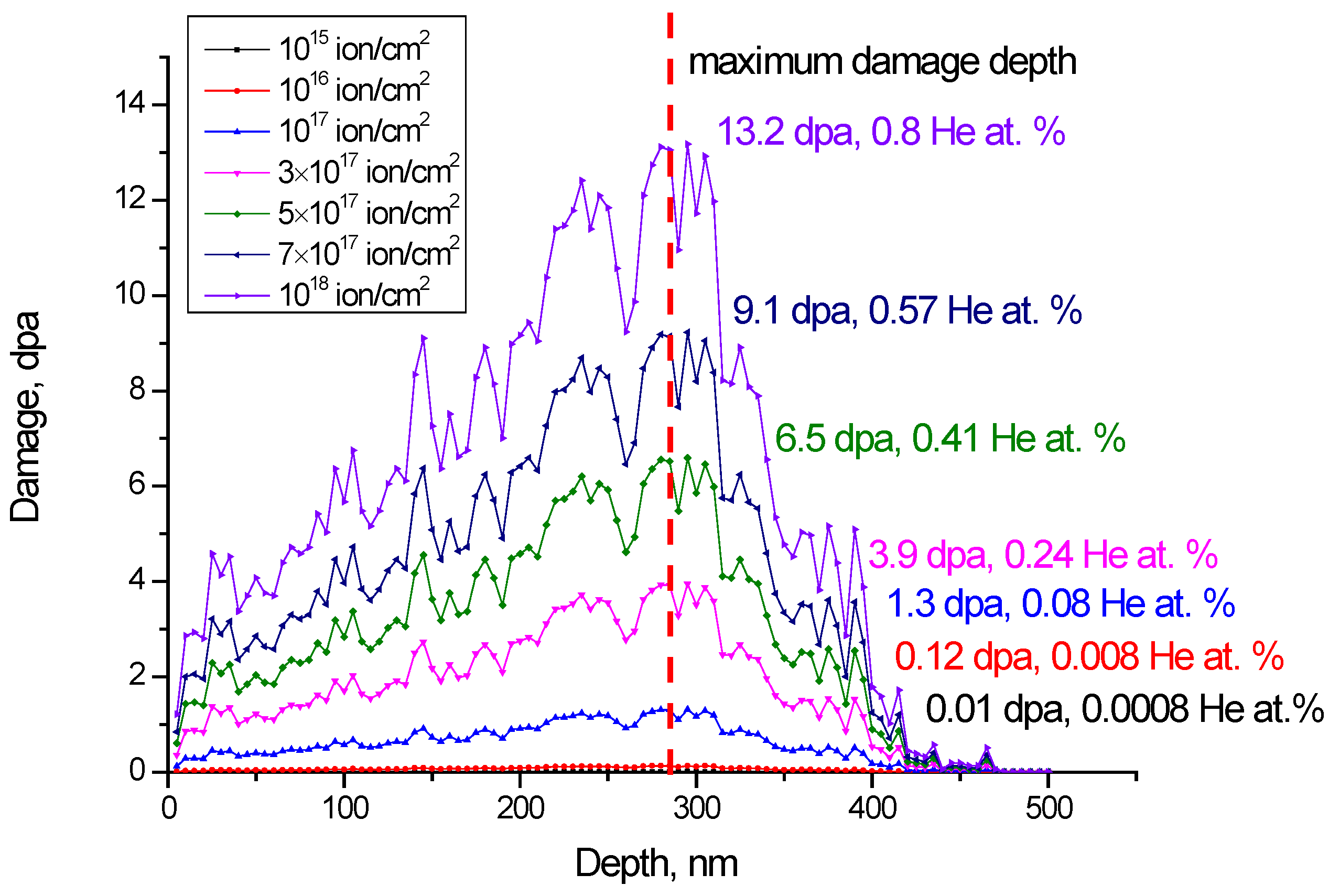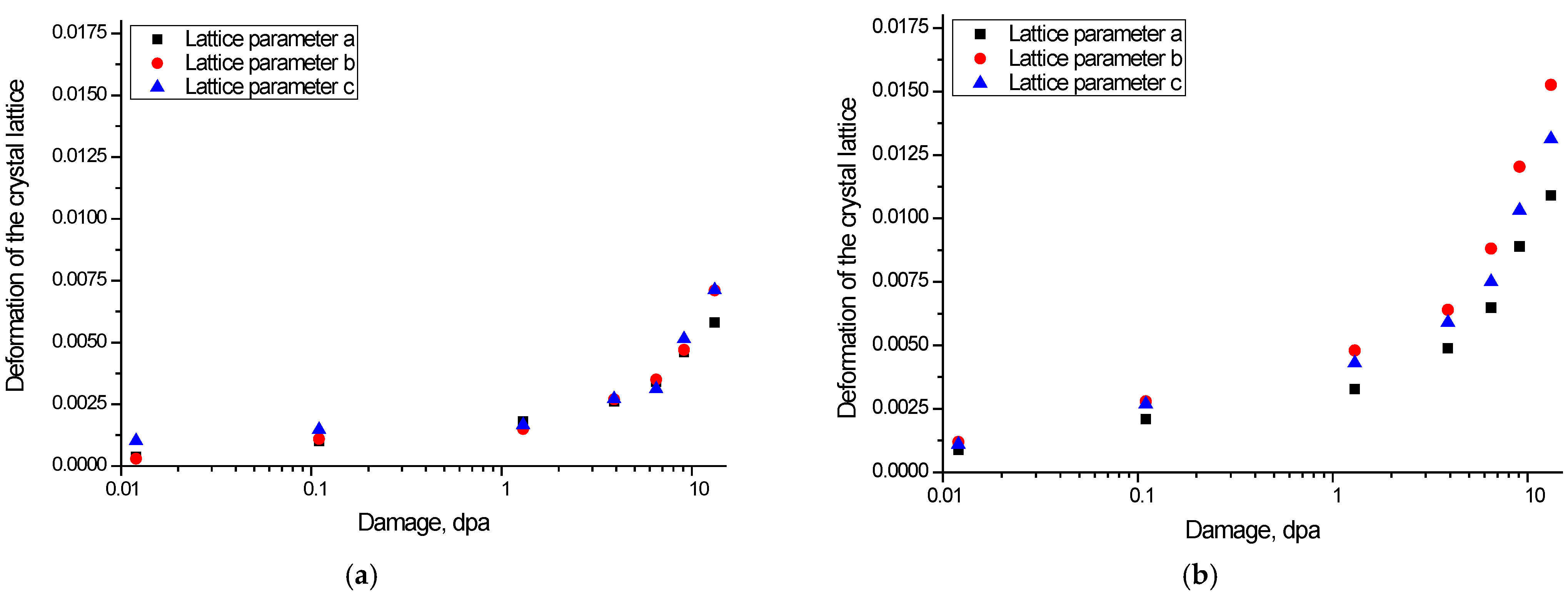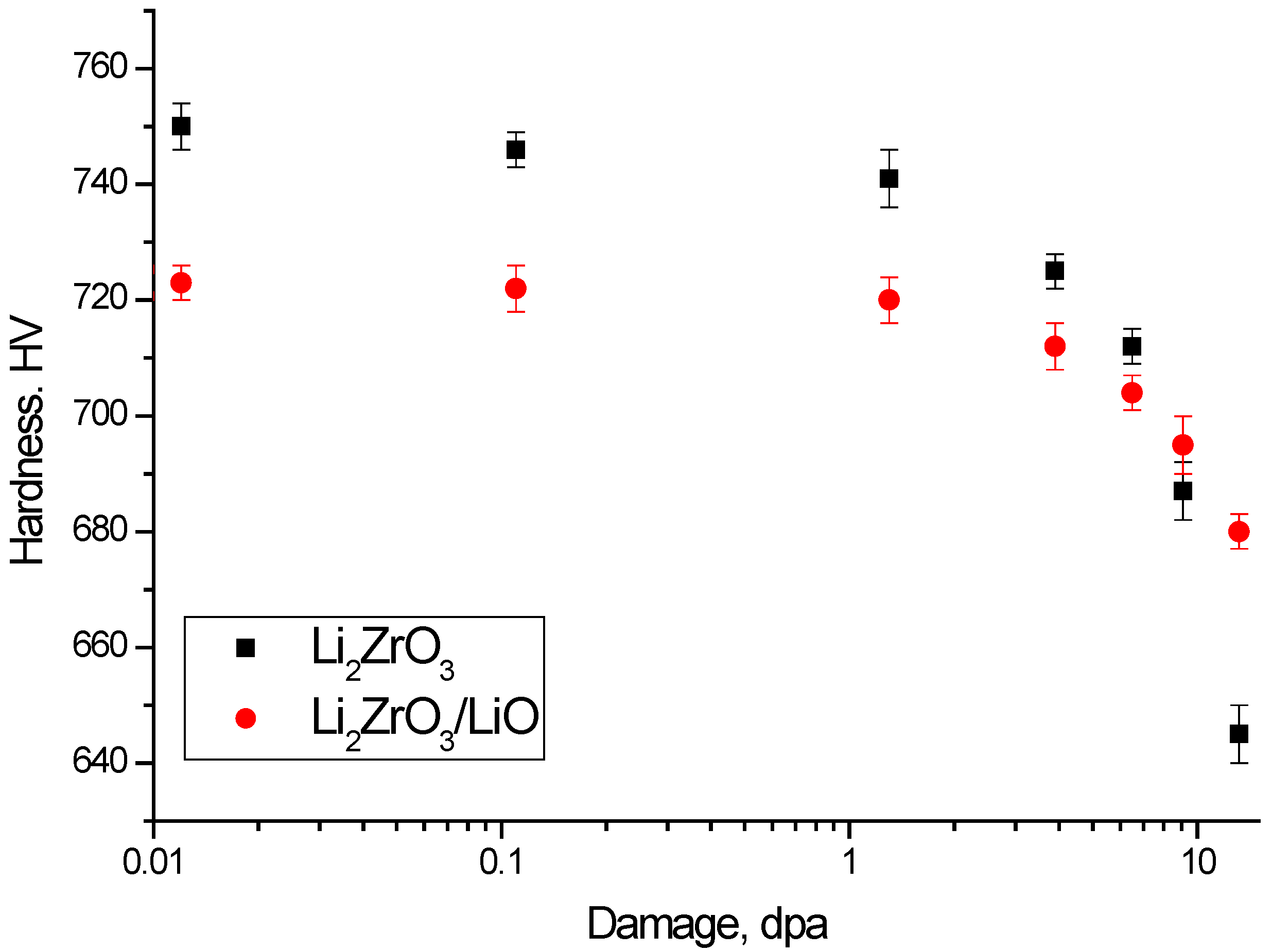Study of Radiation Resistance to Helium Swelling of Li2ZrO3/LiO and Li2ZrO3 Ceramics
Abstract
:1. Introduction
2. Experimental Section
2.1. Sample Synthesis
2.2. Irradiation of Samples
2.3. X-ray Phase Analysis of the Studied Samples
2.4. Determination of Thermal Conductive Properties
3. Results and Discussion
3.1. Characterization of Initial Samples
3.2. Determination of Gas Swelling of the Crystal Lattice
3.3. Results of Changes in Thermal Conductivity
3.4. Results of Changes in Strength Properties
4. Conclusions
Author Contributions
Funding
Institutional Review Board Statement
Informed Consent Statement
Data Availability Statement
Conflicts of Interest
References
- Ekberg, C.; Costa, D.R.; Hedberg, M.; Jolkkonen, M. Nitride fuel for Gen IV nuclear power systems. J. Radioanal. Nucl. Chem. Artic. 2018, 318, 1713–1725. [Google Scholar] [CrossRef] [PubMed] [Green Version]
- Yanez, J.; Class, A.G. Analysis of the accuracy of residual heat removal in gen-IV reactors. Nucl. Eng. Des. 2021, 376, 111102. [Google Scholar] [CrossRef]
- Thomas, J.-B.; Anzieu, P.; Lenain, R. The place and the potential of LightWater Reactors in the transition from Gen-III to Gen-IV. In Nuclear Reactor Systems; EDP Sciences: Les Ulis, France, 2021; pp. 261–322. [Google Scholar]
- Bertrand, F.; Marie, N.; Bachrata, A.; Droin, J.-B.; Manchon, X. Simplified thermohydraulic criteria for a comparison of the accidental behaviour of GEN IV nuclear reactors and of PWRs. In Proceedings of the 18th International Topical Meeting on Nuclear Reactor Thermal Hydraulics (NURETH-18), Portland, OR, USA, 18–22 August 2019; pp. 2483–2496. [Google Scholar]
- Kotomin, E.; Kuzovkov, V.; Popov, A.; Vila, R. Kinetics of F center annealing and colloid formation in Al2O3. Nucl. Instruments Methods Phys. Res. Sect. B Beam Interactions Mater. Atoms 2016, 374, 107–110. [Google Scholar] [CrossRef]
- Koga, Y.; Matsuura, H.; Katayama, K.; Otsuka, T.; Goto, M.; Hamamoto, S.; Ishitsuka, E.; Nakagawa, S.; Tobita, K.; Konishi, S.; et al. Effect of nuclear heat caused by the 6Li(n,α)T reaction on tritium containment performance of tritium production module in High-Temperature Gas-Cooled reactor for fusion reactors. Nucl. Eng. Des. 2021, 386, 111584. [Google Scholar] [CrossRef]
- Averback, R.S.; Ehrhart, P.; Popov, A.I.; Sambeek, A.V. Defects in ion implanted and electron irradiated Mgo and Al2O3. Radiat. Eff. Defects Solids 1995, 136, 169–173. [Google Scholar] [CrossRef]
- Lisitsyn, V.M.; Lisitsyna, L.A.; Popov, A.I.; Kotomin, E.A.; Abuova, F.U.; Akilbekov, A.; Maier, J. Stabilization of primary mobile radiation defects in MgF2 crystals. Nucl. Instrum. Methods Phys. Res. Sect. B Beam Interact. Mater. At. 2016, 374, 24–28. [Google Scholar] [CrossRef]
- Kadyrzhanov, K.K.; Tinishbaeva, K.; Uglov, V.V. Investigation of the effect of exposure to heavy Xe22+ ions on the mechanical properties of carbide ceramics. Eurasian Phys. Tech. J. 2021, 17, 46–53. [Google Scholar] [CrossRef]
- Lushchik, A.; Lushchik, C.; Vasil’Chenko, E.; Popov, A.I. Radiation creation of cation defects in alkali halide crystals: Review and today’s concept (Review Article). Low Temp. Phys. 2018, 44, 269–277. [Google Scholar] [CrossRef]
- Tynyshbayeva, K.M.; Kadyrzhanov, K.K.; Kozlovskiy, A.L.; Kuldeyev, Y.I.; Uglov, V.; Zdorovets, M.V. Study of Helium Swelling and Embrittlement Mechanisms in SiC Ceramics. Crystals 2022, 12, 239. [Google Scholar] [CrossRef]
- Shlimas, D.I.; Kozlovskiy, A.L.; Syzdykov, A.K.; Borgekov, D.B.; Zdorovets, M.V. Study of Resistance to Helium Swelling of Lithium-Containing Ceramics under High-Temperature Irradiation. Crystals 2021, 11, 1350. [Google Scholar] [CrossRef]
- Kotomin, E.; Kuzovkov, V.; Popov, A.I. The kinetics of defect aggregation and metal colloid formation in ionic solids under irradiation. Radiat. Eff. Defects Solids 2001, 155, 113–125. [Google Scholar] [CrossRef]
- Gu, S.; Ji, B.; Qi, Q.; Wang, J.; Zhou, H.-S.; Zhang, Y.; Luo, G.-N. Effects of He irradiation on the microstructure and mechanical performance of Li2TiO3. Nucl. Fusion 2021, 61, 106035. [Google Scholar] [CrossRef]
- Wang, C.; Tu, H.; Su, R.; Gao, J.; King, B.V.; O’Connor, D.J.; Shi, L. Annealing effects on the structure and hardness of helium-irradiated Cr 2 AlC thin films. J. Am. Ceram. Soc. 2021, 104, 593–603. [Google Scholar] [CrossRef]
- Abyshev, B.; Kozlovskiy, A.L.; Zhumadilov, K.S.; Trukhanov, A.V. Study of Radiation Embitterment and Degradation Processes of Li2ZrO3 Ceramic under Irradiation with Swift Heavy Ions. Ceramics 2022, 5, 2. [Google Scholar] [CrossRef]
- Wang, J.; Xu, Y.; Liu, H.-D.; Xiang, M.; Zhou, H.; Zhang, Y.; Luo, G.-N.; Qi, Q. Influence of ion irradiations on the microstructure in the tritium breeder material Li2TiO3. Nucl. Instruments Methods Phys. Res. Sect. B Beam Interactions Mater. Atoms 2019, 450, 189–194. [Google Scholar] [CrossRef]
- Yang, S.; Nakagawa, Y.; Kondo, M.; Shibayama, T. Anisotropic defect distribution in He+-irradiated 4H-SiC: Effect of stress on defect distribution. Acta Mater. 2021, 211, 116845. [Google Scholar] [CrossRef]
- Yang, S.; Nakagawa, Y.; Kondo, M.; Shibayama, T. Electron energy-loss spectroscopic evaluation of depth-dependent swelling of He+ ion-irradiated 4H-SiC correlated with defect type. J. Appl. Phys. 2020, 127, 175106. [Google Scholar] [CrossRef]
- Cipa, J.; Zarins, A.; Supe, A.; Kizane, G.; Zolotarjovs, A.; Baumane, L.; Trinkler, L.; Leys, O.; Knitter, R. X-ray induced defects in advanced lithium orthosilicate pebbles with additions of lithium metatitanate. Fusion Eng. Des. 2019, 143, 10–15. [Google Scholar] [CrossRef]
- Qi, Q.; Wang, J.; Zhou, Q.; Zhang, Y.; Zhao, M.; Gu, S.; Nakata, M.; Zhou, H.; Oya, Y.; Luo, G.-N. Comparison of tritium release behavior in Li2TiO3 and promising core-shell Li2TiO3–Li4SiO4 biphasic ceramic pebbles. J. Nucl. Mater. 2020, 539, 152330. [Google Scholar] [CrossRef]
- Rao, G.J.; Mazumder, R.; Bhattacharyya, S.; Chaudhuri, P. Fabrication of Li4SiO4-Li2ZrO3 composite pebbles using extrusion and spherodization technique with improved crush load and moisture stability. J. Nucl. Mater. 2019, 514, 321–333. [Google Scholar]
- Yang, M.; Gong, Y.; Ran, G.; Wang, H.; Chen, R.; Huang, Z.; Shi, Q.; Chen, X.; Lu, T.; Xiao, C. Tritium release behavior of Li4SiO4 and Li4SiO4 + 5 mol% TiO2 ceramic pebbles with small grain size. J. Nucl. Mater. 2019, 514, 284–289. [Google Scholar] [CrossRef]
- Yang, M.; Zhao, L.; Ran, G.; Gong, Y.; Wang, H.; Peng, S.; Xiao, C.; Chen, X.; Lu, T. Tritium release behavior of Li2TiO3 and 2Li2TiO3-Li4SiO4 biphasic ceramic pebbles fabricated by microwave sintering. Fusion Eng. Des. 2021, 168, 112390. [Google Scholar] [CrossRef]
- Qi, Q.; Ji, B.; Gu, S.; Zhang, Y.; Zhou, H.; Luo, G.-N. Annihilation behavior of irradiation defects induced by γ-ray in biphasic tritium breeding materials xLi2TiO3-(1-x) Li4SiO4. Ceram. Int. 2021, 47, 434–438. [Google Scholar] [CrossRef]
- Zdorovets, M.V.; Kozlovskiy, A.L.; Abyshev, B.; Yensepbayev, T.A.; Uzbekgaliyev, R.U.; Shlimas, D.I. Study of Phase Formation Processes in Li2ZrOCeramics Obtained by Mechanochemical Synthesis. Crystals 2022, 12, 21. [Google Scholar] [CrossRef]
- Zhang, H.; Su, R.; Szlufarska, I.; Shi, L.; Wen, H. Helium effects and bubbles formation in irradiated Ti3SiC2. J. Eur. Ceram. Soc. 2020, 41, 252–258. [Google Scholar] [CrossRef]
- Liu, Y.; Zhu, Y.; Shen, T.; Chai, J.; Niu, L.; Li, S.; Jin, P.; Zheng, H.; Wang, Z. Irradiation response of Al2O3-ZrO2 ceramic composite under He ion irradiation. J. Eur. Ceram. Soc. 2021, 41, 2883–2891. [Google Scholar] [CrossRef]







| Irradiation Fluence, ion/cm2 | Ceramic Type | ||
|---|---|---|---|
| Li2ZrO3/LiO | Li2ZrO3 | ||
| Crystal Lattice Parameters, Å | |||
| Phase Concentration: | 90/10 | 100 | |
| Phase | Li2ZrO3—Monoclinic C2/c(15) | LiO—Hexagonal P-6(174) | Li2ZrO3—Monoclinic C2/c(15) |
| Pristine sample | a = 3.1186, c = 7.6109, V = 64.11 Å3 | a = 5.3921, b = 8.9029, c = 5.3625, β = 111.907°, V = 238.81 Å3 | a = 5.3625, b = 8.8611, c = 5.3415, β = 111.607°, V = 235.91 Å3 |
| 1015 | a = 3.1199, c = 7.6170, V = 64.21 Å3 | a = 5.3942, b = 8.9056, c = 5.3715, β = 111.954°, V = 239.33 Å3 | a = 5.3673, b = 8.8716, c = 5.3474, β = 111.609°, V = 236.61 Å3 |
| 1016 | a = 3.1236, c = 7.6231, V = 64.41 Å3 | a = 5.3975, b = 8.9127, c = 5.3758, β = 111.997°, V = 239.79 Å3 | a = 5.3737, b = 8.8858, c = 5.3559, β = 111.780°, V = 237.49 Å3 |
| 1017 | a = 3.1273, c = 7.63524, V = 64.67 Å3 | a = 5.4018, b = 8.9162, c = 5.3728, β = 112.041°, V = 239.86 Å3 | a = 5.3801, b = 8.9035, c = 5.3645, β = 111.891°, V = 238.44 Å3 |
| 3 × 1017 | a = 3.1311, c = 7.6474, V = 64.93 Å3 | a = 5.4061, b = 8.9269, c = 5.3771, β = 112.131°, V = 240.38 Å3 | a = 5.3887, b = 8.9178, c = 5.3731, β = 111.980°, V = 239.43 Å3 |
| 5 × 1017 | a = 3.1373, c = 7.6627, V = 65.32 Å3 | a = 5.4105, b = 8.9341, c = 5.3793, β = 112.221°, V = 240.71 Å3 | a = 5.3973, b = 8.9391, c = 5.3816, β = 112.070°, V = 240.62 Å3 |
| 7 × 1017 | a = 3.1436, c = 7.6841, V = 65.76 Å3 | a = 5.4169, b = 8.9448, c = 5.3901, β = 112.401°, V = 241.56 Å3 | a = 5.4102, b = 8.9677, c = 5.3966, β = 112.249°, V = 242.34 Å3 |
| 1018 | a = 3.1473, c = 7.6964, V = 66.02 Å3 | a = 5.4234, b = 8.9662, c = 5.4007, β = 112.535°, V = 242.57 Å3 | a = 5.4211, b = 8.9963, c = 5.4117, β = 112.429°, V = 243.96 Å3 |
Publisher’s Note: MDPI stays neutral with regard to jurisdictional claims in published maps and institutional affiliations. |
© 2022 by the authors. Licensee MDPI, Basel, Switzerland. This article is an open access article distributed under the terms and conditions of the Creative Commons Attribution (CC BY) license (https://creativecommons.org/licenses/by/4.0/).
Share and Cite
Abyshev, B.; Shlimas, D.I.; Zdorovets, M.V.; Arshamov, Y.K.; Kozlovskiy, A.L. Study of Radiation Resistance to Helium Swelling of Li2ZrO3/LiO and Li2ZrO3 Ceramics. Crystals 2022, 12, 384. https://doi.org/10.3390/cryst12030384
Abyshev B, Shlimas DI, Zdorovets MV, Arshamov YK, Kozlovskiy AL. Study of Radiation Resistance to Helium Swelling of Li2ZrO3/LiO and Li2ZrO3 Ceramics. Crystals. 2022; 12(3):384. https://doi.org/10.3390/cryst12030384
Chicago/Turabian StyleAbyshev, Baurzhan, Dmitriy I. Shlimas, Maxim V. Zdorovets, Yalkunzhan K. Arshamov, and Artem L. Kozlovskiy. 2022. "Study of Radiation Resistance to Helium Swelling of Li2ZrO3/LiO and Li2ZrO3 Ceramics" Crystals 12, no. 3: 384. https://doi.org/10.3390/cryst12030384







